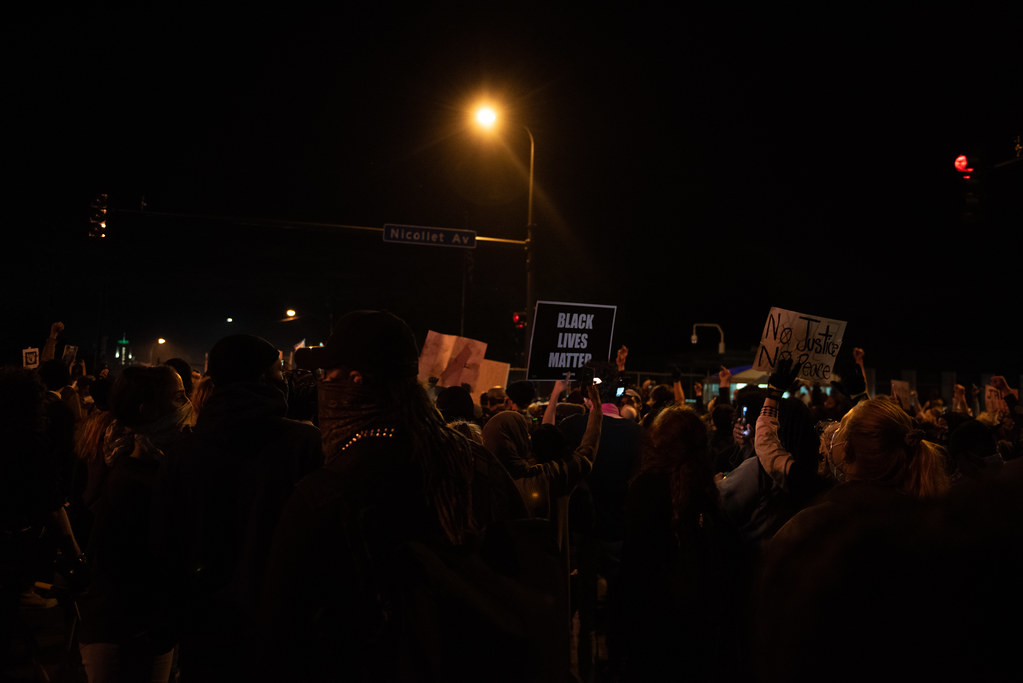Did a Government Drone Flight Over a Protest Violate the Fourth Amendment?
The Supreme Court’s landmark Fourth Amendment decision in Carpenter could impose new limits on aerial surveillance.

Published by The Lawfare Institute
in Cooperation With

On May 28, protestors in Minneapolis demonstrated late into the night against the killing of George Floyd and police brutality. The next day, on Twitter, Jason Paladino of the Project on Government Oversight noticed a Customs and Border Protection (CBP) drone was flying over the city. According to open-source data, as reported by Gizmodo, the drone took off from an Air Force base in Grand Forks, North Dakota, at around 10:10 a.m. At 11:47 a.m., the drone reached Minneapolis, where it entered a “hexagon-shaped holding pattern at 20,000 feet over the city.” About an hour and a half later, around 1:15 p.m., it began its return to Grand Forks.
It is not entirely clear what the drone—suspected to be a Predator B—was doing over the city. After Motherboard initially broke the story, CBP said in a statement that the drone was “preparing to provide live video to aid in situational awareness at the request of our federal law enforcement partners in Minneapolis.” Once the drone arrived in Minneapolis, an agency that CPB declined to name “determined that the aircraft was no longer needed for operational awareness and departed back to Grand Forks.” According to subsequent reporting from the Minneapolis Star Tribune, both the FBI and the Minnesota National Guard denied requesting the drone.
The deployment of the drone raises a host of important legal and policy questions. In a letter to the Department of Homeland Security, Democratic members of the House of Representatives expressed “grave concern” over the drone’s use and demanded information regarding recent Homeland Security surveillance operations. And in another letter to leaders of CBP, the Drug Enforcement Agency, the FBI and the National Guard Bureau, Democratic lawmakers noted that there had been reports of Predator drone use in Detroit and San Antonio during recent protests, among other types of surveillance technologies. But a potentially important legal question remains unexamined: If the CBP commenced a surveillance operation, would that have violated the Fourth Amendment?
The answer to that question depends on a number of details about the purpose, duration and technological capabilities of the operation. The longer and more precise the surveillance, the more constitutionally suspect it would be. Nonetheless, assuming that the government were to deploy the drone over a multiple-day period—two weeks since George Floyd was killed, protests continue across the country—it is possible to draw some preliminary conclusions with respect to the Fourth Amendment.
Leaders of a Beautiful Struggle v. Baltimore Police Department
The most logical starting point for a Fourth Amendment analysis is the recent federal district court decision in Leaders of a Beautiful Struggle v. Baltimore Police Department. In that case, the court denied plaintiffs’ request for a preliminary injunction to prevent the Baltimore Police Department from implementing an aerial surveillance operation called the Aerial Investigation Research (AIR) pilot program. The American Civil Liberties Union (ACLU), which represents the plaintiffs, has appealed that decision to the U.S. Court of Appeals for the Fourth Circuit—and the court has agreed to expedite the proceedings.
According to the district court’s opinion, the AIR program consists of flying three aircraft—operated by a private contractor—over Baltimore for a period of six months. Each plane flies approximately 12 hours a day, collectively covering “about 90 percent of the [c]ity” and “capturing about 32 square miles of the city per image every second.” The planes cannot provide real-time surveillance and they are incapable of operating at night or in bad weather. What they do provide are images in which “1 pixel” represents a single person, meaning that “an individual’s characteristics are not observable in the images.” Those images are then stored for up to 45 days and can be accessed only as part of a criminal investigation for certain crimes, according to an agreement between the police department and the private contractor that maintains the database.
The district court analyzed the Fourth Amendment claim in three parts and determined that the AIR program was not a Fourth Amendment search. First, the court looked to three older precedents—Dow Chemical Co. v. United States (1986), California v. Ciraolo (1986) and Florida v. Riley (1989)—in which the Supreme Court rejected Fourth Amendment challenges to aerial surveillance that the district court found to be “far more intrusive” than the AIR program. Second, the district court surveyed a number of appellate court decisions that “upheld the warrantless use of [video cameras mounted to poles] to observe activities within a given radius” and concluded that those cameras captured more private activities than the AIR program. (The court did not engage, however, with the reasoning in a recent district court decision—that is currently before the First Circuit—that found that extended use of such cameras requires a warrant.)
Third, the district court applied the Supreme Court’s recent decision in Carpenter v. United States (2018), which extended Fourth Amendment protection to seven days’ worth of cellphone location data. (The court’s discussion of Carpenter is the most important part of its analysis since all the cases cited in the first two parts of the opinion were decided pre-Carpenter.) Plaintiffs’ core argument was that, like the cellphone location data in Carpenter, the images collected by the AIR program also allowed law enforcement to track a specific person’s movements over multiple days.
But the court distinguished the AIR program from Carpenter. The district court determined that cellphone location information “offers a far more intrusive, efficient, and reliable method of tracking a person’s whereabouts than the AIR pilot program.” In particular, the court noted that while a cellphone generally relays its location data “several times a minute,” the AIR program’s inability to fly at night and in bad weather creates “gaps in the data [that] will prohibit the tracking of individuals over the course of multiple days.” The court also relied on the fact that the Carpenter court noted that it is “remarkably easy” for law enforcement to track a person’s location with access to their cellphone data. By contrast, it was significant in the court’s view that tracking using the AIR images “requires time-intensive analyses—about 1 hour of labor to track two hours’ of a vehicle’s movements.” And, because the AIR program cannot track people once they are inside their homes, the court found that—unlike cellphone data—the AIR program cannot “expose the ‘privacies of life.’”
Still, the district court’s opinion will not be the last word on the issue—Carpenter’s doctrinal implications are far from settled. On appeal, among other things, the ACLU argues that the district court incorrectly applied Carpenter. In its view, the bad weather and nighttime “gaps” do not defeat the Fourth Amendment claim. The ACLU notes that the Carpenter court upheld a Fourth Amendment claim even though there are gaps in cellphone location data such as when people “turn off their cell phones, leave them at home, or travel out of their service provider’s coverage area.” And the ACLU emphasized that “[f]or most Baltimoreans, who return home at night and leave in the morning from the same place, any of the AIR program’s ‘gaps’ will hardly provide meaningful protection against day-after-day tracking.” Accordingly, the ACLU contends that rather than analyzing the AIR program in discrete 12-hour intervals, the Fourth Amendment claim should be construed as “the daily collection of Plaintiffs’ movements, down to the yard, for 180 days, retained for 45 days at a time.” Lastly, the ACLU sharply contests the relevance of the district court’s reliance on the fact that additional work is required to track a specific person or vehicle’s location.
Drone Surveillance and the Fourth Amendment
At the outset, whether the drone provides law enforcement with retrospective surveillance capabilities—in addition to the real-time feed that the CBP’s statement referenced—would be crucial to the Fourth Amendment analysis. This is important because the Carpenter court placed repeated emphasis on the “retrospective quality of the data” since it gives law enforcement “access to a category of information otherwise unknowable.” While it remains an open question to what extent courts will extend Carpenter to real-time surveillance—Massachusetts’s supreme court already has done so, albeit in a context with some meaningful distinctions from aerial surveillance—it is clear that there would be a stronger Fourth Amendment claim if the footage was retrospectively available to law enforcement than if it was provided only in real time. Still, to the extent that real-time surveillance allowed for the tracking of specific people over an extended period of time, it could trigger Carpenter’s protections for “the record of [a person’s] physical movements.”
If the drone did possess retrospective capabilities, even under the approach taken by the Leaders of a Beautiful Struggle district court, the surveillance would likely constitute a Fourth Amendment search. There are at least two constitutionally significant differences between the flight of the Predator B above Minneapolis and the AIR program that point toward that conclusion.
First, while there is limited public information about the zoom capacity of the Predator B’s camera, it seems likely that it is more precise than the AIR program’s 1 pixel per person. A video on the General Atomics website shows the drone’s capabilities—and it is possible that at a lower altitude, the drone could produce an even clearer picture. (It is also known that CBP is seeking facial recognition-equipped drones.) And as the Project on Government Oversight has noted, manufacturers marketing drones far less sophisticated than the Predator B “highlight their [drones’] ability to pick individuals out of a public gathering.” Second, it is well established that the Predator B has night-vision and infrared capabilities. According to a 2009 Popular Mechanics story, even in the dark, “[t]he video image is so sharp that even from an altitude of more than 3 miles, [the operator] can make out that ... men are carrying large, heavy backpacks.” This means that—compared to the AIR program—there would be even fewer gaps in surveillance, thereby producing a comprehensive portrait of a person’s whereabouts.
The next step in assessing the lawfulness of the search would be to determine whether or not it meets the Fourth Amendment’s reasonableness requirement. (A reasonable Fourth Amendment search would be lawful.) A court’s reasonableness inquiry would be highly fact-specific and is difficult to predict. In Carpenter, the Supreme Court affirmed that “warrantless searches are typically unreasonable where ‘a search is undertaken by law enforcement officials to discover evidence of criminal wrongdoing.’” And the ACLU’s Fourth Circuit brief contends that warrantless, nonparticularized aerial surveillance resembles the form of search in a “general warrant,” which is forbidden under the Fourth Amendment. But the Carpenter court also left open the possibility that even warrantless surveillance might be permissible “if law enforcement is confronted with an urgent situation.”
***
The current protests were not the first—and certainly will not be the last—instance in which the government employs a military-grade drone for domestic law enforcement purposes. According to Freedom of Information Act documents obtained by the Electronic Frontier Foundation, Predator drones were used in dozens of state and federal law enforcement operations between 2010 and 2012. And while advocates have long argued that drone surveillance violates the Fourth Amendment, they now have a new weapon of their own: the Supreme Court’s decision in Carpenter. How far Carpenter will extend, though, remains to be seen.


.png?sfvrsn=48e6afb0_5)


